Feather Meal Market Size
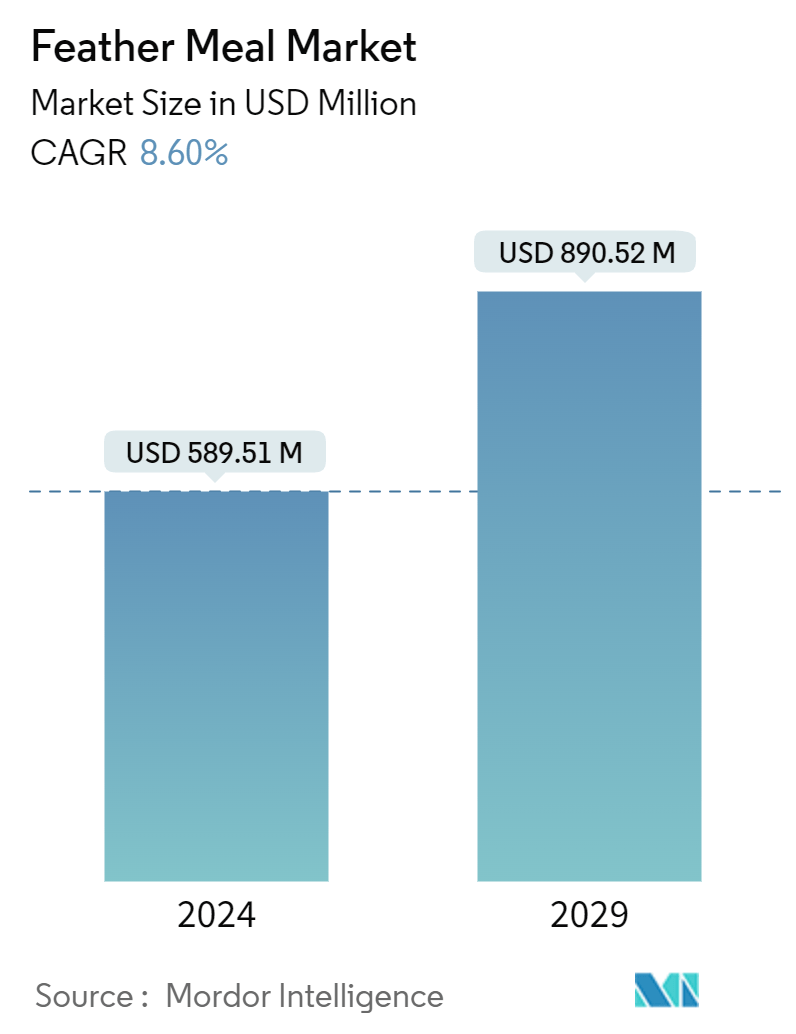
| Study Period | 2019 - 2029 |
| Market Size (2024) | USD 589.51 Million |
| Market Size (2029) | USD 890.52 Million |
| CAGR (2024 - 2029) | 8.60 % |
| Fastest Growing Market | Asia-Pacific |
| Largest Market | Asia-Pacific |
| Market Concentration | Low |
Major Players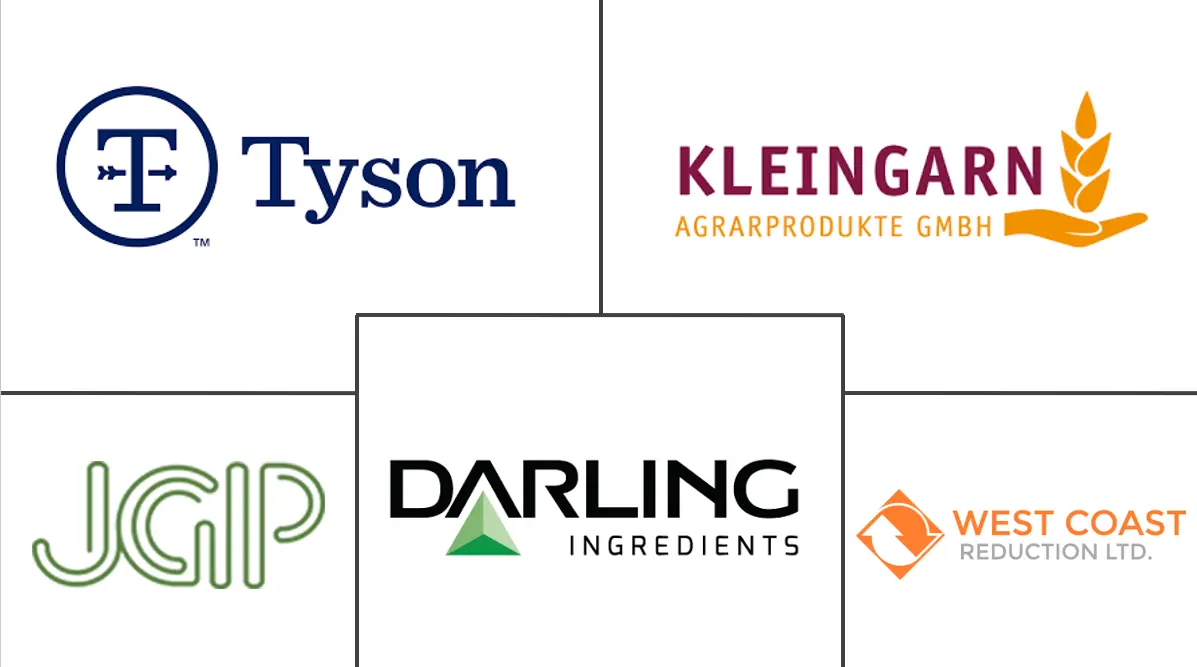
*Disclaimer: Major Players sorted in no particular order |
Feather Meal Market Analysis
The Feather Meal Market size is estimated at USD 589.51 million in 2024, and is expected to reach USD 890.52 million by 2029, at a CAGR of 8.60% during the forecast period (2024-2029).
- Feather meal is a concentrated source of protein, typically containing 60% to 70% crude protein. It provides essential amino acids, including lysine, methionine, and cysteine. These nutritional characteristics make feather meal a valuable protein source for livestock and animal feed formulations. Therefore, with the benefits incurred from feather meal coupled with the increasing costs of feed ingredients in recent years, is driving the market for feather meal market. Smallholder dairy and livestock farming is prevalent in developing regions of Asia and Africa. However, these farmers often struggle to meet their production goals due to inadequate animal nutrition, primarily caused by the high cost of traditional livestock feed.
- The price disparity between feather meal and other protein sources highlights its potential as a cost-effective alternative. According to Penn State Extension, in 2023, the average price of a feather meal was USD 661.83 per metric ton, compared to USD 1,788.44 per metric ton for a fish meal and USD 1,159.32 per metric ton for a blood meal. Incorporating by-products like feather meal into compound feed can significantly reduce feed costs, potentially increasing the global availability of affordable feedstocks.
- The global expansion of poultry production contributes to a substantial supply of feathers, which can be processed into feather meal. According to the Food and Agriculture Organization (FAO), the global chicken population has reached 26 billion, ensuring a steady source of raw materials for feather meal production.
Feather Meal Market Trends
Increasing demand for organic farming accelerating feather meal market
Over the past decade, increased awareness of organic food benefits has led to a surge in organic farming popularity. In this context, by-product organic fertilizers are gaining traction over plant-based varieties due to their superior water absorption and retention properties, which enhance soil fertility. Feather meal, a by-product of organic fertilizer, is emerging as a valuable resource in this sector. Its ability to retain essential nutrients in the soil for extended periods is opening up significant market opportunities. According to Epic Gardening in 2023, feather meal serves as an excellent organic fertilizer, rich in nitrogen, capable of replacing many synthetic liquid fertilizers in organic farming operations.
Feather meal (FM) fertilizers are increasingly replacing synthetic liquid fertilizers in organic horticultural applications. This organic alternative provides plants with sufficient nitrogen and promotes growth. Organic vegetable growers, particularly those cultivating nitrogen-intensive crops like corn, prefer high-quality feather meal products. The growing awareness among farmers about the nutritional benefits of plant and animal-based fertilizers, along with their role in promoting earthworm activity and other beneficial microbial processes, is driving the adoption of organic fertilizers. Feed tables indicate that feather meal contains 85.7% crude protein and 12% nitrogen. As the demand for organic farmland continues to rise, the market for organic fertilizers, including feather meal, is expected to grow in the coming years.
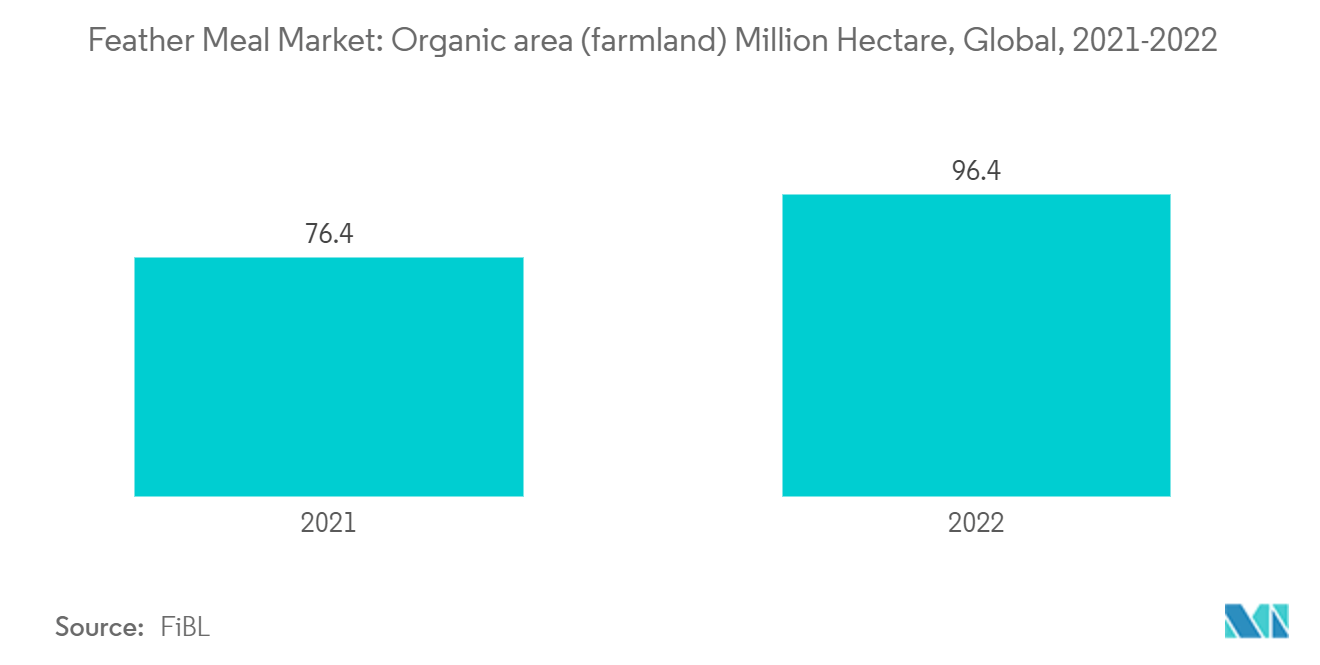
Asia-Pacific to Drive the Feather Meal Market
Asia-Pacific is emerging as a significant region in the food processing industry, particularly in poultry and meat processing. The region's vast agricultural production and diverse animal resources have positioned it as one of the world's top food-producing areas. The poultry production and processing sector is experiencing rapid growth. For instance, in 2022, China led poultry production in Asia-Pacific with a 41.87% share, followed by Indonesia at 10.44% and India at 9.96%. In China, some of the most popular poultry breeds include white broiler, yellow broiler, hybrid, and ex-layer. These breeds' feathers are popularly used in the production of feather meal in the country.
According to Poultry World, Asia hosts the largest poultry population globally, with 3 billion birds, as of 2023. To ensure food safety, an organized processing industry is developing. Modern broiler processing plants can handle between 200,000 and 1,000,000 birds daily, generating substantial waste material. Currently, feather meal remains an underutilized protein source in the region. However, increasing awareness of its nutritional benefits is expected to contribute to addressing global protein needs by boosting animal protein production and potentially restructuring pricing in the market.
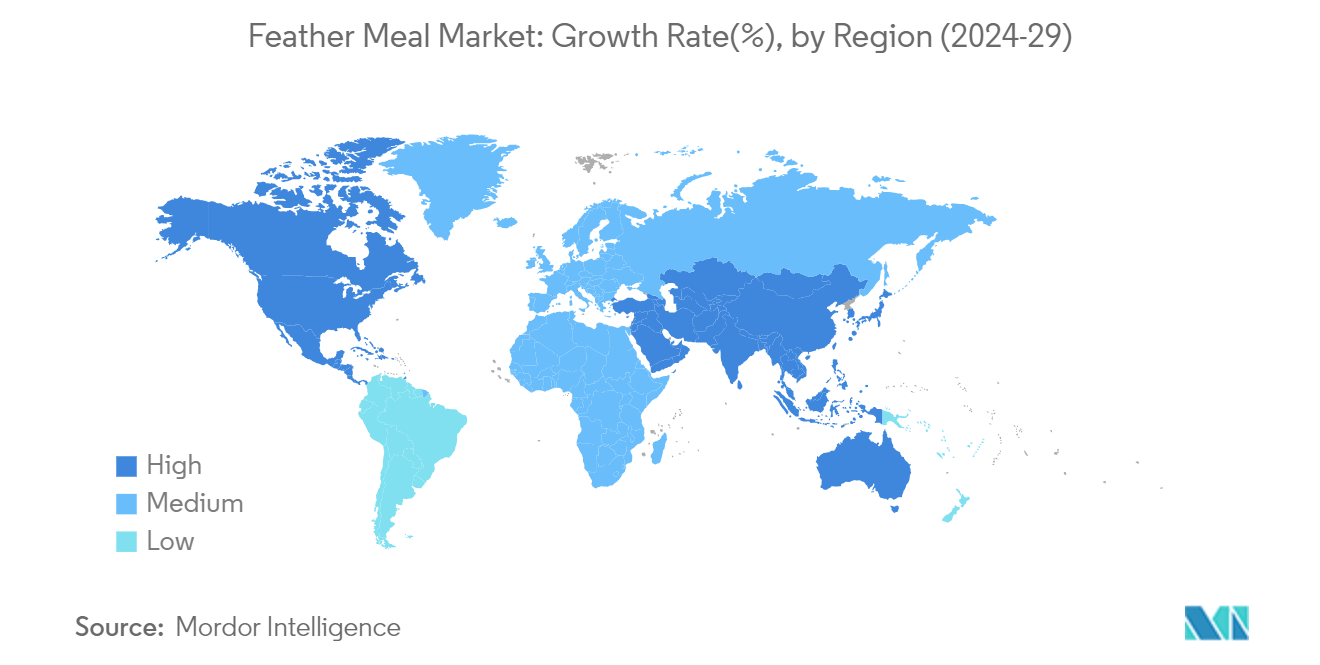
Feather Meal Industry Overview
The global feather meal market is fragmented, with numerous small and medium-sized companies holding minimal market share worldwide. Companies such as K-Pro U.S., JG Pears, FASA Group, Kleingarn Agrarprodukte, and Darling Ingredients contribute to this fragmentation, resulting in intense competition. During the study period, strategic developments, particularly acquisitions, have strengthened the market. The emergence of regional markets and local players in various parts of the world is the primary factor contributing to the market's fragmented nature.
Feather Meal Market Leaders
-
JG Pears
-
Kleingarn Agrarprodukte
-
Darling Ingredients
-
West Coast Reduction Ltd.
-
Tyson Foods Inc.
*Disclaimer: Major Players sorted in no particular order
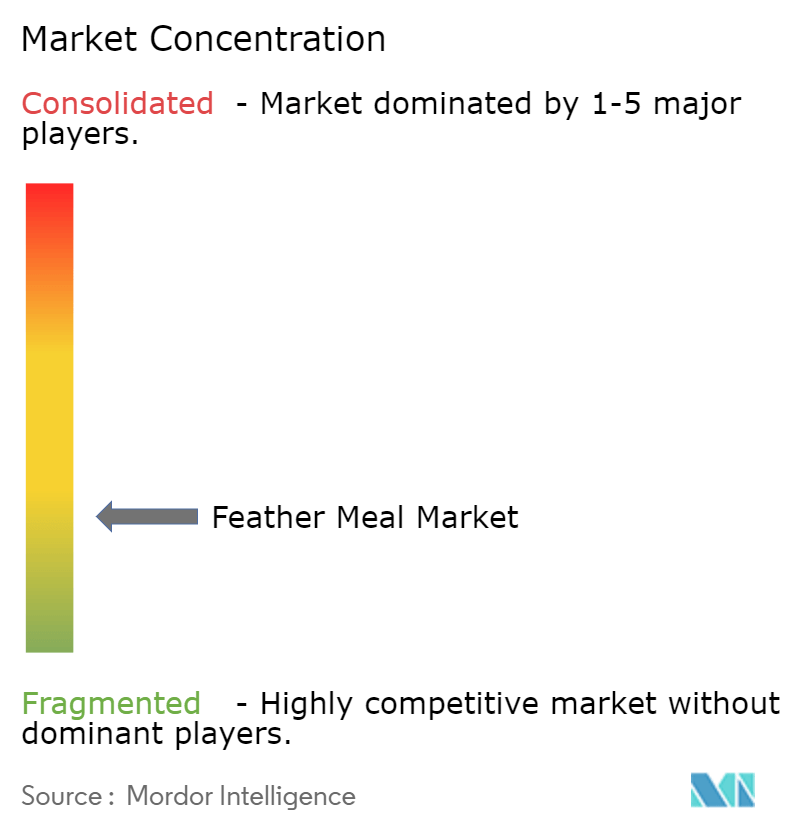
Feather Meal Market News
- January 2024: Darling Ingredients acquired the Polish rendering company Miropasz Group. This acquisition added three poultry rendering plants in southeastern Poland that produce 250,000 metric tons of poultry byproducts annually.
- May 2022: Darling Ingredients acquired Valley Proteins for USD 1.1 billion. This acquisition added 18 major rendering plants and used cooking oil facilities across the southern, southeastern, and mid-Atlantic regions of the United States. The acquisition expanded Darling Ingredients' feather meal production capacity.
- May 2022: Darling Ingredients acquired FASA Group for USD 560 million. This acquisition added 16 rendering plants with an annual processing capacity of 1.3 million metric tons. The acquisition expanded Darling Ingredients' feather meal production capacity.
Feather Meal Market Report - Table of Contents
1. INTRODUCTION
1.1 Study Assumptions and Market Definition
1.2 Scope of the Study
2. RESEARCH METHODOLOGY
3. EXECUTIVE SUMMARY
4. MARKET DYNAMICS
4.1 Market Overview
4.2 Market Drivers
4.2.1 Increased Poultry Production
4.2.2 Rising usage of Feather Meal in Pet Food Industry
4.2.3 Relatively Low Price of Feather Meal
4.3 Market Restraints
4.3.1 Competition from Synthetic Amino acids
4.3.2 Regulatory Challenges
4.4 Porter's Five Forces Analysis
4.4.1 Threat of New Entrants
4.4.2 Bargaining Power of Buyers/Consumers
4.4.3 Bargaining Power of Suppliers
4.4.4 Threat of Substitute Products
4.4.5 Intensity of Competitive Rivalry
5. MARKET SEGMENTATION
5.1 Type
5.1.1 Conventional
5.1.2 Organic
5.2 Application
5.2.1 Animal Feed
5.2.2 Agrochemicals
5.2.3 Other Applications
5.3 Geography
5.3.1 North America
5.3.1.1 United States
5.3.1.2 Canada
5.3.1.3 Mexico
5.3.1.4 Rest of North America
5.3.2 Europe
5.3.2.1 Germany
5.3.2.2 United Kingdom
5.3.2.3 France
5.3.2.4 Russia
5.3.2.5 Spain
5.3.2.6 Rest of Europe
5.3.3 Asia-Pacific
5.3.3.1 China
5.3.3.2 India
5.3.3.3 Japan
5.3.3.4 Indonesia
5.3.3.5 Rest of Asia-Pacific
5.3.4 South America
5.3.4.1 Brazil
5.3.4.2 Argentina
5.3.4.3 Rest of South America
5.3.5 Middle East and Africa
5.3.5.1 South Africa
5.3.5.2 Egypt
5.3.5.3 Rest of Middle East and Africa
6. COMPETITIVE LANDSCAPE
6.1 Market Share Analysis
6.2 Most Adopted Strategies
6.3 Company Profiles
6.3.1 The Boyer Valley Company
6.3.2 Tyson Foods Inc.
6.3.3 North Country Organics
6.3.4 Darling Ingredients
6.3.5 Kleingarn Agrarprodukte
6.3.6 Sanimax Industries
6.3.7 JG Pears
6.3.8 West Coast Reduction Ltd.
7. MARKET OPPORTUNITIES AND FUTURE TRENDS
Feather Meal Industry Segmentation
Feather meal, a byproduct of poultry processing, is produced by partially grinding chicken feathers under high heat and pressure. This study considers feather meal as a feed ingredient used in the commercial compound feed industry. The global feather meal market is segmented by type (conventional and organic), application (animal feed, agrochemicals, and others), and geography (North America, Europe, Asia Pacific, South America, Middle East, and Africa). The report provides market size and forecasts in terms of volume (metric tons) and value (USD) for all segments.
| Type | |
| Conventional | |
| Organic |
| Application | |
| Animal Feed | |
| Agrochemicals | |
| Other Applications |
| Geography | ||||||||
| ||||||||
| ||||||||
| ||||||||
| ||||||||
|
Feather Meal Market Research FAQs
How big is the Feather Meal Market?
The Feather Meal Market size is expected to reach USD 589.51 million in 2024 and grow at a CAGR of 8.60% to reach USD 890.52 million by 2029.
What is the current Feather Meal Market size?
In 2024, the Feather Meal Market size is expected to reach USD 589.51 million.
Who are the key players in Feather Meal Market?
JG Pears, Kleingarn Agrarprodukte, Darling Ingredients, West Coast Reduction Ltd. and Tyson Foods Inc. are the major companies operating in the Feather Meal Market.
Which is the fastest growing region in Feather Meal Market?
Asia-Pacific is estimated to grow at the highest CAGR over the forecast period (2024-2029).
Which region has the biggest share in Feather Meal Market?
In 2024, the Asia-Pacific accounts for the largest market share in Feather Meal Market.
What years does this Feather Meal Market cover, and what was the market size in 2023?
In 2023, the Feather Meal Market size was estimated at USD 538.81 million. The report covers the Feather Meal Market historical market size for years: 2019, 2020, 2021, 2022 and 2023. The report also forecasts the Feather Meal Market size for years: 2024, 2025, 2026, 2027, 2028 and 2029.
Feather Meal Industry Report
Statistics for the 2024 Feather Meal market share, size and revenue growth rate, created by ����vlog��ý™ Industry Reports. Feather Meal analysis includes a market forecast outlook to 2029 and historical overview. Get a sample of this industry analysis as a free report PDF download.



